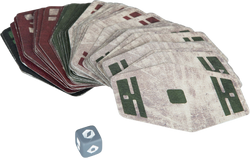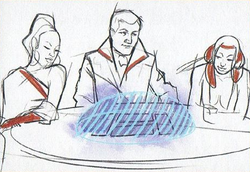- "I do enjoy a game of sabacc. Preferably the Corellian spike variation - fewer cards to count. Err, I mean, play."
- ―Diago Velaar
"Corellian Spike" was a variation of sabacc that used a 62-card deck and two six-sided dice called "spike dice." The object of the game was to achieve a card total closest to 0. When the dice rolled doubles, each player's hand was discarded and replaced by unseen cards from the deck, which could improve or ruin their hand.
Cards and dice[]

A deck of Corellian Spike sabacc with single spike die
The Corellian Spike variation of sabacc was played with a smaller deck, comprising only 62 cards[4] rather than 76.[5]
The first 60 cards were divided in three suits (referred to as "staves"): circles, triangles, and squares. There were twenty cards in each stave: ten green cards with positive values from 1 to 10, ten red cards with negative values from -1 to -10. The remaining two cards in the deck had a value of 0,[2] and were referred to as sylops (Old Corellian for "idiots").[4]
The game also made use of two "spike dice,"[4] which were rolled thrice per round to shake things up.[6]
Gameplay[]

Corellian Spike players
Unlike regular sabacc,[7] the object of Corellian Spike was to collect a hand as close to a value of 0 as possible.[4]
Each game lasted three rounds. At the start of the first round, each player placed two credits in the game pot, and one in the sabacc pot. The dealer then dealt each player two cards, which they kept secret. The remaining cards, placed face down, constituted the draw pile.[6]
Starting from the dealer's left, the players betting saw a player's bet, raised a bet, stood, or decided to junk their cards. In the latter case, their cards were discarded, face up, on the discard pile. A player who chose discard their cards was out of the game until the next round started.[6]
At the end of the betting phase, the dealer dealt each remaining player a third card face up, the spike card. At that point, each player had the opportunity to buy a card for two credits added to the game pot. If they chose to do so, they were given the top card face down from the draw pile. After that, they could either discard the new card, swap it with one of the two cards in their hand, or swap it with the spike card.[6]
Then, the players bet again. The dealer would then roll the two spike dice. If the symbols were the same but not double spikes, all active players had to discard two cards from their hands, and were dealt two new ones. If double spikes were rolled, however, all active players had to discard all three cards and were given new ones, with the new spike card once again face up.[6]
The sequence "option to buy a card, betting, and rolling of the dice" would then occur again two more times in succession. At that point, if more than one player remained, players all revealed their hands. The one with the best hand won the game pot. If said hand had a value of exactly zero, the player in question also won the sabacc pot.[6]
Winning hands[]
There existed several versions of the rules, with different hierarchies of winning hands.[6] In one version that could be bought at the Toydarian Toymaker on Batuu, there were 20 possible winning hands: Pure sabacc, Full Sabacc, Fleet, Yee-Haa, Rhylet, Squadron, Gee Whiz, Straight Khyron, Bantha's Wild, Rule of Two, Sabacc, Sabacc with most cards, Sabacc with highest value cards, Sabacc with highest single value card, Nulrhek, Nulrhek with positive score, Nulrhek with most cards, Nulrhek with highest value cards, Nulrhek with highest single value card, and Single Blind Draw.[2]
However, according to the Yarith Bespin casino's house rules, the best winning hand was the "Idiot's Array," consisting of a sylop (0) coupled with a +2 and a +3. In that system, the next best hand was the "Prime Sabacc," which consisted of a +10, a -10, and a sylop (0).[6]
History[]
In 10 BBY,[8] Han Solo won the Millennium Falcon from Lando Calrissian in a game of "Corellian Spike" sabacc[1] on the planet Numidian Prime.[9]
Appearances[]
- Solo: A Star Wars Story
- Solo: A Star Wars Story: Expanded Edition (and audiobook)
- Solo: A Star Wars Story Adaptation 3
- Solo: A Star Wars Story Adaptation 7
- Star Wars: Hunters (Mentioned only)
- Pirate's Price (and audiobook)
Star Wars: Galactic Starcruiser — Sublight Lounge (Mentioned only)
Non-canon appearances[]
Sources[]
- Star Wars: The Force Awakens: The Visual Dictionary (First mentioned)
- The Last Jedi: Rose Tico: Resistance Fighter
- Solo: A Star Wars Story The Official Guide
- Solo: A Star Wars Story: Tales from Vandor
- Star Wars: The Complete Visual Dictionary, New Edition
- Solo: A Star Wars Story home video release — Featurette: "Scoundrels, Droids, Creatures and Cards: Welcome to Fort Ypso"
- Star Wars: Smuggler's Guide
- Star Wars: How Not to Get Eaten by Ewoks and Other Galactic Survival Skills
 Star Wars: X-Wing Second Edition — Fireball Expansion Pack (Card: Coaxium Hyperfuel) (Reissued in Hotshots and Aces Reinforcements Pack) (Picture only)
Star Wars: X-Wing Second Edition — Fireball Expansion Pack (Card: Coaxium Hyperfuel) (Reissued in Hotshots and Aces Reinforcements Pack) (Picture only)- Star Wars 100 Objects
 Game On: A Look at Sabacc and Dejarik on StarWars.com (backup link)
Game On: A Look at Sabacc and Dejarik on StarWars.com (backup link)
External links[]
The Star Wars Show: Vader Immortal First Look and Meet the Cast of Star Wars Resistance on the official Star Wars YouTube channel (backup link) (Posted on StarWars.com)
Notes and references[]
- ↑ 1.0 1.1 Star Wars: The Force Awakens: The Visual Dictionary
- ↑ 2.0 2.1 2.2 Sabacc at Galaxy's Edge
- ↑ Star Wars: Hunters
- ↑ 4.0 4.1 4.2 4.3 The Last Jedi: Rose Tico: Resistance Fighter
- ↑ Sabacc (Celebration Anaheim)
- ↑ 6.0 6.1 6.2 6.3 6.4 6.5 6.6 6.7 Solo: A Star Wars Story: Tales from Vandor
- ↑
 "Rebel Bluff" — Star Wars Insider 158
"Rebel Bluff" — Star Wars Insider 158
- ↑ Solo: A Star Wars Story The Official Guide
- ↑ Solo: A Star Wars Story: Expanded Edition

